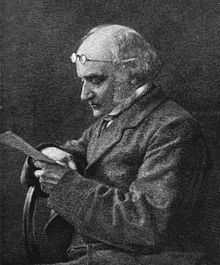John Brown (physician)
| John Brown | |
|---|---|
 | |
| Born |
22 September 1810 Biggar, South Lanarkshire |
| Died | 11 May 1882 (aged 71) |
| Nationality | Scottish |
| Occupation | physician, essayist |
John Brown FRSE FRCPE (22 September 1810 – 11 May 1882) was a Scottish physician and essayist. He was the son of the clergyman John Brown (1784–1858), and was born in Biggar, Scotland. He is best known for his 3 volume collection Horae Subsecivae—"Leisure Hours" (1858), including essays and papers on art, medical history and biography. Among the former, his dog story, Rab and his Friends (1859), and his essays Pet Marjorie (1863)—on Marjorie Fleming, the ten year old prodigy and "pet" of Walter Scott,[1] Our Dogs, Minchmoor, and The Enterkine are especially notable.
He was the half-brother of the organic chemist Alexander Crum Brown.
Biography

Brown was educated at the Edinburgh High School and graduated as M.D. at the University of Edinburgh in 1833, and practised as a physician in that city. John Brown was descended from eminent Presbyterian clergymen. After graduating MD in 1833 he was apprenticed, to James Syme. Brown subsequently acquired a very large medical practice in Edinburgh at a time when infectious diseases took a heavy toll of life. He was a very sociable man, and his house in 27 Rutland Street was the scene of many social gatherings. In 1840 he married Catherine Scott McKay. They had three children, of whom only a son survived. In 1847 Dr Brown became a Fellow of the Royal College of Physicians of Edinburgh, and for a while was Honorary Librarian. He held strong views on the inappropriateness of examinations to evaluate student progress and was unimpressed by the view that scientific advances were in patients' best interests.
He was the friend of many contemporaries, including Thackeray; his reputation is based on the two volumes of essays, Horae Subsecivae (Leisure Hours) (1858, 1861), John Leech and Other Papers (1882), Rab and His Friends (1859), and Marjorie Fleming: a Sketch (1863). His first writing was in response to a request for contributions to the notices of paintings exhibited by the Royal Scottish Academy. The editor of the Scotsman newspaper then asked him to write regularly for the paper. He was 48 years old when he published Rab and His Friends. His writings were philosophical, classical, artistic, medical, of rural life, the Jacobite Rebellion, notable characters, humble folk and canine friends. These were published as a collection in 1858 as Horæ Subsecivæ, which ran to many editions. The first volume deals mainly with the equipment and duties of a physician, the second with subjects outside his profession.
Brown was revered and beloved to uncommon degree, and he was the cherished friend of many of his most distinguished contemporaries, including Thackeray. Among those whose writing he encouraged was Henrietta Keddie, then a schoolgirl in Leith, who would become a prolific novelist and writer for children.[2] In the mingling of tenderness and delicate humour Brown has much in common with Lamb; in his insight into dog-nature he is unique. He wrote comparatively little; but all he did write is good, some of it perfect, of its kind.
He suffered during the latter years of his life from attacks of melancholy. He died on May 11, I882, and was buried in his father’s plot in New Calton Cemetery.
References
- ↑ Waterston, Charles D; Macmillan Shearer, A (July 2006). Former Fellows of the Royal Society of Edinburgh 1783–2002: Biographical Index I. Edinburgh: The Royal Society of Edinburgh. ISBN 978-0-902198-84-5. Retrieved December 27, 2010.
- ↑ Visit Scotland site. Retrieved 2 August 2013.
| Wikisource has the text of the 1911 Encyclopædia Britannica article Brown, John (Scottish physician 1810–1882). |
- Eastwood, Martin (2010) "John Brown (1810–1882)" Journal of the Royal College of Physicians of Edinburgh 40: pp. 281–282, doi:10.4997/JRCPE.2010.320
- McLaren, E.T. (1890) Dr John Brown and his Sister Isabella (4th edition)
- Letters of Dr John Brown, edited by his son and U.W. Forrest, with biography by ET McLaren (1907)
- Peddie, Alexander (1893) Recollections of Dr. John Brown Percival and Company, London, OCLC 3743073
 This article incorporates text from a publication now in the public domain: Chisholm, Hugh, ed. (1911). Encyclopædia Britannica (11th ed.). Cambridge University Press
This article incorporates text from a publication now in the public domain: Chisholm, Hugh, ed. (1911). Encyclopædia Britannica (11th ed.). Cambridge University Press This article incorporates text from a publication now in the public domain: Cousin, John William (1910). A Short Biographical Dictionary of English Literature. London: J. M. Dent & Sons. Wikisource
This article incorporates text from a publication now in the public domain: Cousin, John William (1910). A Short Biographical Dictionary of English Literature. London: J. M. Dent & Sons. Wikisource
- The Reader's Encyclopedia
External links
- Works by or about John Brown at Internet Archive (scanned books original editions)
- Works by John Brown at Project Gutenberg (plain text and HTML)
|